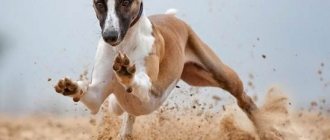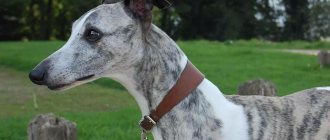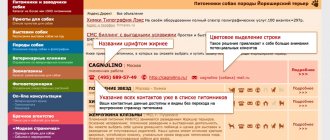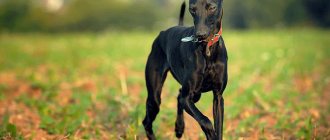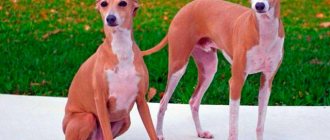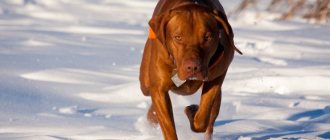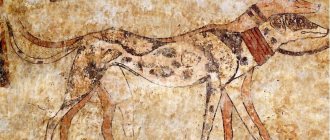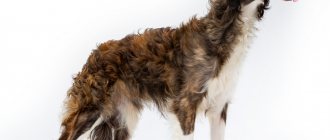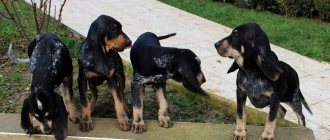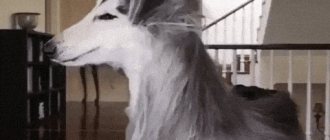Maintenance and care
Small size and poor coat obliges the owner to keep the Whippet indoors all year round. In addition, a ward deprived of undercoat quickly freezes in winter and overheats in summer. Warm clothing for Whippets is a must-have accessory, although hardening should not be ignored. Shoes will be unnecessary, since the dog's claws are involved in maintaining balance. The breed is very active and requires long walks, at least 2 walks of 40-60 minutes each. For dogs of any age, sports activities are also recommended - coursing, swimming, running next to a bicycle.
Whippets do not require meticulous grooming, only brushing and bathing as needed. Shedding occurs 2 times a year, hair loss is not extensive, but long-lasting. Considering the length of the guard hair, the dog must be combed with a rubberized brush. Otherwise, care consists of regularly examining the eyes and ears for inflammation. Teeth and claws (provided the dog is healthy) do not require special care.
Nutrition for a greyhound is a balance of energy (that is, carbohydrates) and dietary intake, since excess weight is detrimental to a lightweight skeleton. The natural diet of an adult dog is based on beef (up to 40%), light grains (buckwheat, rice) and vegetables. Industrial feeds for Whippets are premium (not inferior) quality products for active dogs. There are no specialized “breed” foods on the market yet, since Whippets are not so common, but products for greyhounds are available for sale
The only “but” is that the line is designed for short-haired dogs (usually lines for long-haired animals include a large amount of vitamins for wool, due to a decrease in the content of pure proteins)
Whippet care
The Small English Greyhound is undemanding in care; even a novice dog breeder can handle it. The first big advantage of such a pet is the possibility of keeping it both in a private house and in a city apartment. Such a dog will be an excellent city dweller, even if there is not too much space - its dimensions are very compact. Considering its hunting purpose, the whippet will need a lot of physical activity - walks should be daily and take from 1 to 3 hours. In safe areas, you should let your dog run around. In winter, short-haired pets cannot stay outside for a long time, so it is better to reduce the walking time and put on warm clothes for the dog.
In the cold season, the whippet will have to be dressed for walks
Caring for a whippet requires compliance with the following rules:
- Quality food. Whippets have sensitive digestion, so all food must be of high quality and fresh. Industrial food should be chosen from the holistic or super premium category, designed for medium-sized animals (Hill's Science Plan for adult dogs of medium breeds, Applaws Dry Dog Lamb Small & Medium Breed Adult, etc.). A natural diet must include: meat (more than 60% of the daily portion of food),
- vegetables and unsweetened fruits,
- greenery,
- fermented milk products (cottage cheese, kefir),
- safe cereals (rice, buckwheat, etc.).
Maintenance and care
In winter, the shorthaired whippet gets cold. They select overalls, raincoats, etc. according to size and so that they do not hinder movements. During particularly cold periods, wear a hat or hood. If there is no need, it is better not to wrap the dog up again.
In the summer, it is important to take care that your pet does not overheat. In hot weather, it is better to stay in the shade and wet your ears and paw pads with cold water.
It’s good if you have the opportunity to get out into a clean body of water - swimming is useful. If your pet doesn't show interest in water, don't force it.
Feeding
Whippet needs dry food of at least premium quality. The serving size is always indicated on the packages; it is convenient to select food that matches the age, condition and lifestyle of the dog. With this diet, the dog drinks more water.
Description of an approximate diet with natural nutrition:
- Meat – beef, lamb, poultry;
- Fish (preferably sea fish, carefully remove bones);
- Eggs;
- Fermented milk products: kefir, cottage cheese, fermented baked milk;
- Cereals: rice, buckwheat (it is useful to add a little vegetable oil to porridge);
- Vegetables: pumpkin, zucchini, carrots, bell peppers;
- Fruits are allowed.
Not allowed: fried, salty, sweet, fermenting, spoiled, sour foods.
Grooming
Wool does not require complex care - it is enough to regularly remove dead hairs. It is convenient to use a special rubberized glove for these purposes. Combing is also a useful massage.
Bathe 3-4 times a year with shampoo for short-haired dog breeds. Human cosmetics cannot be used. After a walk (especially in winter), you need to wash your paws.
Tireless runners usually grind down their claws themselves. If they grow faster, use a nail clipper for medium breeds; you can correct them with a file. Be sure to praise and treat your pet after this manipulation - it is unpleasant for most dogs.
The eyes are examined every day. Dust etc. is carefully removed with a clean cloth dampened in cool water.
You should brush your teeth every 2-3 days. Get a special toothbrush and toothpaste (non-foaming) for dogs.
Nutrition
A whippet's diet should be natural and balanced to reduce the risk of disease. You should not give up vitamin complexes to maintain immunity and high-quality feed containing animal protein.
It is recommended to give preference to the following products:
- Lean raw meat (chicken, beef, rabbit, turkey).
- Chopped, boiled or stewed vegetables/vegetable broths (carrots, zucchini, cucumber, pumpkin).
- Dried offal.
- Seafood.
- Porridge (buckwheat, oatmeal, rice).
- Vegetable oil.
- Cereals, vegetables and fruits.
- Boiled fish without bones.
- Eggs (chicken, quail).
- Low-fat fermented milk products.
The size of the required portion must be calculated based on the dog’s body weight (no more than 10-12% of weight). Before the puppy turns 2 months old, he is fed 6 times a day, then the number of meals is reduced to 3 (not earlier than six months) and 3 (a year).
You can keep your uppet in an apartment only if you take long walks every day.
Maintenance and care
The small size and lack of undercoat do not allow the Whippet to be kept outside. This breed of dog is designed to live in a house.
In the cold season, the whippet must be dressed in warm overalls before going for a walk.
Since whippets do not have an undercoat, the dog gets very cold during winter walks. For this reason, your pet’s wardrobe should have at least one winter overall or insulated blanket.
In addition, the dog must be protected from chilly autumn and spring winds. A raincoat made of waterproof fabric will provide protection; it will keep the dog warm. It would be a good idea to put together a summer wardrobe for your whippet. But shoes will be superfluous - the dog’s claws should be open. They help the dog maintain balance while running.
The breed is quite active, so you need to walk the dog twice a day for forty to sixty minutes. To satisfy the animal's need for movement, experts recommend active walks - coursing, running next to a bicycle or swimming.
Care of fur, teeth, claws
The whippet's coat does not require too much care. It is enough to brush your dog with a special brush once or twice a week. This breed sheds in spring and autumn. During this period, the dog must be combed daily.
It is typical for dogs of this breed to lack the characteristic dog smell, so there is no need to bathe the animal often.
It is very important to periodically examine your dog’s teeth and if you find tartar, contact your veterinarian. In order to prevent the formation of hard plaque on tooth enamel, the dog should be given chewing bones and toys intended for cleaning teeth.
In addition, the dog's ears, eyes and claws should be examined periodically.
Whippet mating
Whippet mating has its own characteristics. It is best to breed dogs on the 11th day from the start of estrus.
Whippet mating is best done under the supervision of an experienced instructor.After fully entering heat, the bitch is ready to mate until the end of her heat. But in old bitches, late matings may have no result or result in the birth of one or two puppies.
If we talk about the frequency of mating, then it all depends on the preferences of the whippet owner. Sometimes one meeting of dogs is enough to get normal offspring.
After mating has occurred, the owner’s task is to help the dog get off the bitch so that all four paws are on the floor. To prevent dogs from trying to disperse and injuring themselves, they must be wearing a paired collar. The couple can remain in this position for 10 minutes to an hour. During this period, animals should not be disturbed. We need to wait for them to disperse on their own.
After mating, the whippets are separated into different rooms. Dogs can be fed after half an hour.
Preparation for mating is standard. If your dog is overweight, then you need to get rid of it. If there is a shortage of kilograms, the animal is fattened.
The whippet bitch's first breeding season occurs at approximately 10 months. The first mating is recommended when the dog is 2 years old.
After mating, dogs can be fed half an hour later.
How to choose a puppy
Whippet puppies, like adults, amaze with their aristocracy and athletic build. When you look at them, you sometimes get the impression of slight exhaustion. But still, kids should not be excessively thin. Their frisky behavior should create the impression of proper care and maintenance.
A distinctive feature of the greyhound is its arched back. But it shouldn't look like a hump. The head is streamlined, elongated towards the nose, without pronounced transitions in the forehead area. The feet should be level, with arched toes and large, strong pads. The breed's tail resembles a whip and does not rise above the level of the back.
When choosing a pet, inspect the ears and eyes. Feel the tummy, which should be soft. Run your fingers along the ribs. If small, slightly palpable growths are found, this may indicate rickets. The same goes for joints. They should not be painful or enlarged except for the growth points. The short coat should lie close to the body, be shiny, smooth and without bald spots.
By the time of sale, that is, by two months, puppies must have received all necessary vaccinations. Since whippets are naturally cowardly, try to choose the puppy that is least afraid of a sharp sound or clapping of your hands.
Choosing a puppy
Whippets are a numerous breed, but they are not very widespread in Russia. This largely explains the high cost of puppies - from 25 thousand rubles. In addition, finding a free animal is not always easy - you will have to stand in line at the official nursery.
It is difficult to confuse a Whippet puppy with a dog of another breed; babies have the same appearance features as adult representatives: spaced ears, a long tail, graceful high limbs, an elongated muzzle. Confirmation of ownership will be an official pedigree describing the origin of a particular animal.
Whippet puppies are very similar to adult representatives of the breed
Health and life expectancy
Whippets suffer from congenital deafness and eye diseases.
The average lifespan of dogs of this breed is 11 – 16 years, but on average dogs live 13 years. The advantage of the breed is excellent health. Whippets are not characterized by food allergies and joint dysplasia, diseases characteristic of greyhounds. But even they have their problems.
The breed has a tendency to:
- Congenital hearing loss. Puppies are born immediately deaf or lose their hearing in the first three weeks of life. There is no treatment, since the cause of the pathology lies in abnormal intrauterine development.
- Eye diseases - various inflammations, cataracts, entropion/eversion of the eyelid, conjunctivitis, third eyelid adenoma.
- Pseudogemophilia (von Willebrand disease). Hereditary pathology resembling hemophilia. Symptoms are continuous bleeding without cause. Most often, dogs experience bleeding from mucous membranes - the mouth, nose and internal organs.
Whippets suffer from congenital deafness and eye diseases.
Quite often, whippets experience increased sensitivity to medications.
It is recommended to use narcotic substances (anesthesia) with extreme caution. Puppies require mandatory vaccination as they are susceptible to viral pathologies.
Whippet diseases
Whippets live on average 12–15 years and are in good health. The breed has a long history and has always been used for hunting, so weak representatives and dogs with deviations were constantly culled. So, they practically do not have joint dysplasia (impaired joint formation), but other defects may occur:
- Deafness. If there is no hearing from birth, nothing can be done; the dog can easily live without this feeling.
- Heart disease, in particular mitral valve stenosis (narrowing of the left opening between the atrium and ventricle). In the initial stages, the problem does not have pronounced symptoms, but shortness of breath gradually appears, and the dog quickly gets tired. Treatment involves endoscopic surgery to install a special balloon to repair the hole in the valve. This procedure allows you to transfer the disease to the stage of insufficiency, which will subsequently be compensated by taking medications.
- Corneal dystrophy is a congenital ophthalmological disease that involves damage to the cornea of the eye. If your dog has a gray, white, or shiny cloudy appearance in his eye, you should see a doctor right away. Dystrophy can manifest itself both in puppyhood and in old age. To eliminate the problem, they resort to complex surgery.
Intolerance to anesthesia is one of the most serious problems most often encountered by owners of English Greyhounds. A minimal amount of adipose tissue significantly reduces resistance to drugs, so a standard dose of anesthesia can be fatal for a pet. If such manipulation is necessary, everything should be discussed with the veterinarian in advance.
Dogs often get injured in competitions
If a whippet participates in competitions, then injuries come to the fore - sprains, dislocations, cuts, fractures. This is due to the high speed that the dog develops and the general risk of such events.
Breed dossier
1. Country of origin: Great Britain.
2. Classification: Group 10. Greyhounds. Section 3. Short-haired greyhounds.
3. Training: not very difficult. However, Whippets have a strong hunting instinct. From early childhood, Whippets must be taught to walk on a leash and obey commands. If the dog is not well-trained, then it is possible that during a walk it will rush after the cat and chase it like game. This cannot be allowed.
4. Color: all colors in any combination are acceptable.
5. Dimensions. Height at the withers: males: 42 - 45 cm, females 42 - 45 cm. Weight: 10 - 12 kg.
6. General impression: a graceful, harmoniously built dog of light constitution. Light and agile, the Whippet gains tremendous speed when running.
7. Use: hunting dog, companion dog.
8. Physical activity: active. The whippet is used to running a lot and chasing game, but if his movement is limited, he becomes irritable and quickly gains excess weight.
It is important for this dog to release its accumulated energy.
9. Character: active, gentle, good-natured. These dogs love to be close to their owner. This is a great family dog. She loves all family members equally, but sometimes becomes attached to the person who spends the most time with her. The Whippet requires a lot of attention. This breed is not recommended for people who go on long business trips and are often away from home. Without communication with a person, without proper education, the Whippet will become a wild, fearful dog.
11. Grooming: not difficult at all. The Whippet has short, close-fitting fur that is easy to care for. Representatives of this breed actively shed in spring and autumn; during this period they need to be thoroughly brushed with a natural bristle brush. You shouldn't bathe your Whippet often; it's not always beneficial. This procedure should only be performed if absolutely necessary.
12. Accommodation: excellent.
13. Diseases: congenital and acquired deafness, allergic reaction to anesthetics.
14. Diet: balanced. Whippets should not be overfed; these dogs quickly lose shape and gain excess weight. It is not recommended to feed your dog from the table, as this may cause it to develop gastrointestinal diseases.
15. Life expectancy: 12 – 15 years.
Photo: Whippet
Historical reference
Experts have quite clearly defined the history of the greyhound breed group. Historians have been able to reconstruct and describe the development paths of almost every breed. Since ancient times, greyhounds were used for hunting without a gun; other types of weapons were used. Thanks to long legs, streamlining and lightweight bones, tailed animals developed high running speed. The elongated muzzle and wide set of eyes increased the visibility of four-legged hunters. The purpose of the dog during the hunt was to drive and drive game into an open area. Depending on the landscape, the size of the prey and the skills of the tailed animals, the “jumps” could last up to several hours.
The Whippet dog still does not have a clearly defined origin story. More precisely, there are a number of versions, some of which contradict each other. There are also several side “stories”. A rather strange assumption is that small greyhounds were bred by miners. Dogs cleared mines of rats and protected people. Perhaps, but why not terriers, because this breed group has always been common, terriers are smaller, angrier to animals and more convenient in “dirty” work.
The "official" versions look like this:
Naturally, it is impossible to name the exact date of birth of Roman mythology, but approximately 100 years BC, a hierarchy of deities already existed. The more legendary Apollo, Atlas, Hercules and Neptune eclipsed with their masculinity one very interesting goddess - Diana. The figure of the queen of flora and fauna was often depicted at a T-shaped intersection in the company of an animal. In the stern of the fawn, often adjacent to the goddess, there was also a dog - a copy of the Whippet. That is, if you trust the ancient Roman sculptors and assume that the image of the animal was adopted from life, then the Whippet may turn out to be the “big brother” of the Greyhound. Further, in 50–40 BC, the warlike Romans brought their dogs to the islands of Great Britain, and there the breed developed and eventually became English.
Well, now some facts. The Whippet of the 19th century and modern representatives of the breed are quite different in appearance. Paintings, sculptures and other monuments depict dogs similar to modern representatives of the breed. Further, driving a hare is a long-known practice, and greyhounds are one of the oldest genera of canines. Of course, we do not have the right to debunk “official theories,” but their compilers overlooked one important fact - although the small Greyhound was not recognized, it existed. Also known to history is the female and long-haired Greyhound Whippet, probably obtained from a mixture of the blood of the Small Greyhound and the Bedlington Terrier. That is, in high probability, the Whippet is the result of centuries of breeding work carried out by both nature and people. The hunter has a large amount of blood in his family, both from purebred sires and from 100% mongrels with suitable skills. That is, the theory that the breed appeared only in the 19th century is rather doubtful.
No less interesting events accompanied the breed on the threshold of its recognition by the English Federation of Cynology in 1903. Experts tried to draw up a breed standard, but an unexpected problem arose. Against the backdrop of contrasting opinions of dog handlers from different countries and against the backdrop of quite serious competition at the time of the Whippet’s recognition, the first pancake “came out lumpy” in the international understanding. The FCI (Fédération Cynologique Internationale) requires a detailed description of the breed, including each individual dog trait. English dog handlers do not recognize such a “system” and prefer to standardize their charges as a whole. Nevertheless, the breed was recognized both in England and in the world, and its compressed standard was “adjusted” to the requirements of key cynological organizations.
Training and education
The Whippet is a willful, independent dog, although it is very attached to its owner. He is smart, so you can not only teach him different commands, but also make him an athlete, a guard, or a shepherd.
This type of hound can even perform various circus tricks. The hunting instinct is developed in such dogs so strongly that the owner only needs to direct it in the right direction.
The Whippet will not simply carry out commands. It is necessary to establish trusting contact with him and find an approach to him. During training, corporal punishment and any other rough treatment are excluded.
Such an approach will only discourage the dog from continuing the lessons and obeying. With the right approach, the owner will be able to understand that the Whippet is considered the most manageable greyhound.
The main thing in the training process is to be patient; for correct execution, you should reward your pet with treats and praise. It is recommended to conduct lessons in a playful way with intense physical activity.
Interesting Facts
- In paintings with images of the goddess Diana, next to her in almost all cases there is a small dog, in appearance it is almost a complete copy of the whippet.
- In its homeland, the whippet is often called the “bull terrier among greyhounds.”
- In the Louvre there is an exhibit in the form of a sculpture of a dog exactly like a whippet. The sculpture dates back to the fifth century BC.
- A whippet is capable of detecting a hare in a matter of seconds, using its sense of smell, and overtaking it in a couple of seconds.
- Representatives of the breed are capable of reaching speeds of up to 70 km/h.
- “To move quickly, nimbly” is what the English word whippet means.
- A whippet barks extremely rarely; if you hear the voice of a greyhound, it means that it is announcing something important.
History of the breed
The history of the Whippet begins with the appearance of another greyhound, the Greyhound, in England. It was from her that they originated. But the Greyhound is a large dog that requires a lot of care and a lot of food, and not everyone could keep it.
The middle class needed a smaller dog and breeders in northern England began selecting the smallest Greyhounds and crossing them with other breeds.
It is known that among them there was an Italian greyhound, extremely popular at that time.
There is no doubt that they crossed with terriers, it is believed that one of them was the Bedlington - a terrier that is common in this region and is distinguished by long legs.
Small greyhounds at that time were called whippets or "Snapdogs". The term first appears in 1610, but was then applied to a different type of dog.
The English word "Whippet" comes from "whip" and means whip. They were called so for their high speed, similar to the blow of a whip.
At some point, whippets began to be called small greyhounds. It is unclear when this happened, but after 1788, since the Encyclopedia Britannica published that year does not contain any mention of this breed.
In the 19th century, a significant part of the British lived in cities and greyhound racing became very popular. The Whippet is called the "poor man's greyhound" or "poor man's greyhound."
He has a really high speed, although it is determined by the size of the dog, and breeds like the Greyhound or Saluki are capable of reaching the maximum. However, if we consider speed regardless of size, the Whippet is the fastest breed in the world.
It can accelerate to 64 km/h. In addition, they are able to make sharp turns without losing much speed. At that time, the whippet is one of the important components of the family budget. On the one hand, he is able to hunt an animal, on the other hand, he can successfully compete in dog racing and win money. Since that time, they have been bred to achieve maximum speed, although their hunting qualities are also in demand.
The 19th century whippet was a little different from the modern one, much less refined and more like a mongrel. Some have clearly visible terrier traits, they do not resemble either small greyhounds or purebred dogs.
Over time, the upper class of society became interested in the breed. At this time, dog shows come into fashion and breeders want to get more spectacular dogs. Their goal is to get a dog that looks like a classic greyhound, but not as big.
As a result of breeding work, the features of other breeds begin to disappear from the appearance of the Whippet. The breed was first recognized by the English Kennel Club in 1891 and has since gained great popularity for its grace and sophistication.
Historical reference
The breed has a long history, shrouded in mystery. The origin of the greyhound has not been scientifically proven; it is only known that it was intended for hunting wild rabbits.
Most likely, the Whippet has been naturally selected over the years. Its qualities can be found in many hounds and greyhounds.
In the 19th century, dog racing became popular in England and whippets were bred to participate in competitions. At the start, the assistant threw the whippet onto the track, and the incentive to run was the owner, who waved a handkerchief at the finish line.
The breed was quite affordable and became very common among the middle class and poor.
After the ban on dog fighting, another form of entertainment became popular: baiting hares in a pen with several dogs. At that time, whippets were different from their modern counterparts - they often crossed with mongrels and did not have a noble appearance. Later, high society became interested in the breed and famous dog breeders began breeding.
The Whippet breed was first registered in 1891, and the conformation standard was approved in 1903 by the English Federation of Cynologists.
Whippets appeared in Russia in the early 90s and are still rarely seen, although kennels sell dogs of very high quality.
Formation of the breed
Like many greyhounds, the history of the Whippet breed is quite complicated. There are several conflicting versions of the origin of the breed. The first says that the whippet is a relatively young breed, which was bred in the 19th century by miners and factory workers for hunting and racing. Based on this version, the Whippet is a cross between Manchester Terriers, Greyhounds and other breeds, for example, Foxhounds.
However, as a result of recent research, dog experts have come to the conclusion that the breed is much more ancient. Almost always, the goddess Diana was depicted accompanied by dogs that looked very much like the modern whippet. In addition, many animals with the same appearance are depicted in the paintings of masters of the 14th-16th centuries. The Louvre houses a sculpture from the 4th century BC, apparently depicting a whippet.
According to the latest version, the ancestors of this breed were brought to the islands of Britain by the Romans in 55 BC. e. Some experts believe that these animals are the descendants of the Pharaoh Hound. From this medium-sized greyhound came the Greyhound and the Whippet, developing as two separate but very similar branches.
Best articles: Description and features of the natural forest-steppe zone
Probably, the solution to the mystery of the appearance of the breed lies somewhere in the middle. It is unlikely that researchers will be able to find out the true history of whippet breeding, but it is quite obvious that the formation of this breed and various terriers occurred in parallel, and therefore their influence on each other is beyond doubt.
Nowadays, the Whippet dog differs from its closest relatives, the Greyhounds, in its greater distrust of strangers and its brighter temperament. This suggests the presence of terrier blood in them. The British even call representatives of this breed “bull terriers among greyhounds.” And this is quite justified, since the Whippet was used much later to breed terrier breeds (Bedlington Terrier, Bull Terrier).
The first detailed description of the Whippet breed appeared in Great Britain in the mid-19th century. And in 1891 it was officially registered and began to rapidly gain popularity not only in Britain, but also in other countries. Then a period of oblivion began in the history of the breed. But now small greyhounds are again at the peak of popularity in Europe.
The Whippet breed standard, adopted in 1903, has changed little. The most famous nurseries in Great Britain were Manorley and Shirley. In Russia, the first dogs of this breed appeared in 1988 at the Elite breeding center. Ten puppies were brought from Germany, Czechoslovakia and Poland. They turned out to be of high breed and produced excellent offspring.
Description of the breed, characteristics
Purebred dogs have a harmonious physique and thick coat. The body is tightly built with well-developed muscles. Despite the lightweight bones of the skeleton, the joints are well positioned. The muzzle is shortened and this feature makes Schipperkes have an attractive appearance. Males and females have differences in size and proportions.
Modern Belgians are considered companions, ideal for family life; in addition, dogs can serve as protectors. Representatives of this breed are cheerful, energetic and curious animals. They are constantly moving, interested in the world around them and enjoy exploring previously unknown places.
Such fidgets need frequent and long walks so that they can throw out excess energy. Otherwise, the Schipperke will begin to show increased activity, which consists of constantly spinning underfoot and getting attached to the pets. Belgians take great pleasure in traveling, and they really enjoy traveling by car, when the dog can admire the surrounding landscape through the window.
Representatives of this breed are able to spend a lot of time in outdoor games, and therefore Schipperkes are often found in families with children. True, adults will have to forget for a long time what peace and quiet is due to the noisy company. Worth knowing. Belgian dogs are not the best option for those with very young children.
Careless handling makes the pet extremely irritable.
Despite their small size, the dogs are very brave, fearless and strong. If the need arises, the animal will enter into a fight with an opponent of large size. It all comes down to education; if a dog is not trained correctly, it becomes a real problem. Schipperkes can become aggressive even to their owners.
Belgians are famous for their vigilance; they do not miss a single extraneous sound, and notify about them with a loud bark. This behavioral feature causes trouble for both the owner and others, which means it needs to be corrected. Trained dogs quickly fall silent as soon as they are given a specific command.
Whippet Characteristics
| Attachment level | High |
| Friendliness | High |
| Suitable for children | Yes |
| Loyalty to other pets | High |
| Exercise needs | High |
| Playfulness | High |
| Energy level | Average |
| Learning ability | High |
| Intelligence | Average |
| Tendency to bark | Low |
| Shedding amount | Low |
Whippet dog character
This is a very active, sociable and cheerful dog that gets along well with children. However, it is worth getting such a dog only if the children are old enough and understand that the dog cannot be harmed. Whippets are friendly towards people, but only towards their owner. This is a breed of dog that does not bark unless absolutely necessary - only in truly extreme cases. Whippets live well in apartments; you cannot leave your pet outside, as it gets very bored without its owner. Dogs of this breed constantly want to be in human company and love to play outside. If there is a sufficiently old school-aged child in the house, the Whippet is a wonderful pet that will not get tired of playing for hours.
But whippets treat strangers with special caution - if strangers are often present in the house, this is not the breed of dog that you need. The dog gets along well with dogs, because by nature he was bred to participate in racing, and there is no time to sort things out
In order for a whippet to start rushing at its relative, something out of the ordinary must happen. But the whippet is less loyal to cats and other small pets - hunting instincts can take over, and the dog will begin to look for its prey.
High speed and unprecedented excitement are the reasons why a dog should not be allowed outside without a collar. If a whippet sees a squirrel or a cat, it will be impossible to keep up with the dog. Moreover, the pet will be so carried away that you will not be able to direct the filming to yourself; the dog simply will not respond. That is why the dog must be walked with a collar and released only in safe areas. Despite the fact that the Whippet is very active in nature, at home it is a real sloth who loves to sleep. Older people often love the dog for this character trait - the dog spends energy on the street, but does not bother you in the house.
When trained, the dog is very smart, remembers and follows commands well, and tries to please its owner. But dogs of this breed have a rather delicate and sensitive nervous system. You cannot shout at a whippet, much less use force on it. The dog may become confused and refuse to carry out the command; in some cases, the dog no longer wants to do what was previously well learned and reinforced. The dog has no other reasons to refuse to follow a command. It is believed that the Whippet is the easiest dog to train in the entire breed group. You can achieve good results with affection, care and tasty encouragement.
There is an opinion that whippets cannot become good watchmen or guards because they have little aggression. Indeed, there is some truth in this. If you need to develop certain watchdog qualities in your dog, you need to train the puppy from an early age.
Pros and cons of the breed
The Whippet breed is suitable even for owners who have no experience in dog breeding. Such a pet will become an excellent friend, companion, and hunting assistant. But before you place a whippet in your home, think carefully about whether you can provide him with decent maintenance, attention and love. Below are the main pros and cons of this breed.
Advantages:
1. Elegant appearance. 2. Attachment to the owner, friendliness. 3. Cleanliness, no dog smell. 4. Easy care. 5. Gets along with children. 6. Learning abilities. 7. Suitable for apartment maintenance. 8. Good health. 9. Rarely barks.
Coat and color
The coat of Whippet puppies is short, soft and very pleasant to the touch. The coat fits tightly to the body; sometimes there are individuals with hard hair, but they are not included in the standards.
As for the coat color, it can have a different appearance and be not only monochromatic, but also in several colors.
The Whippet's color can be as follows: white, black, blue, sand, brindle, red-red, isabella.
Depending on the color of the Whippet, the pigmentation features of its nose and eyes change.
Any of the colors listed above can also be combined with white to create a spotted pattern.
How to choose a puppy
- Ask the seller how often he breeds his bitch. For real professionals interested in the development of the breed, Pharaoh Hounds produce offspring no more than once a year.
- An indicator of the normal condition of the little “pharaoh” is the folds on the body. If there are none, and the baby’s ribs are clearly visible, most likely the animals are underfed.
- In serious nurseries, all producers are tested for dysplasia. If the results of veterinary examinations are not presented when meeting the litter, it is better not to risk it and choose another breeder.
- Pharaoh hound puppies that are less than 2.5 months old have a bluish tint to the iris. With age, the eyes will change color to the standard amber.
- If you are buying a puppy under three months of age, be prepared for floppy ears. In pharaoh dogs, the ear tissue assumes a vertical position only in the fourth month of life, and sometimes the process needs to be accelerated by gluing the cartilage with a plaster.
- Slight thickening in the joint area in Pharaoh babies is a normal phenomenon, which will disappear as they grow older. But lameness, an unsteady gait and slightly twisted limbs are a reason to refuse the deal.
- A mentally healthy Maltese rabbit puppy should respond appropriately to touch. If, when you pick up an animal, you feel it trying to break free and run away, this is a bad sign.
Description of the nature of the breed
In addition to their graceful appearance, whippets have the same sophisticated nature. These dogs behave completely differently at home and when walking or competing and hunting. At work, dogs are furiously energetic and fast. They are able to quickly and furiously drive a hare or cover a distance with lightning speed. During walks, they behave no less recklessly. But everything changes as soon as they cross the threshold of the house - they become calm and almost invisible.
Whippets are good-natured and affectionate. They are equally devoted to all family members.
When interacting with children, you must carefully ensure that the child does not hurt the dog during games. She will never respond.
Dogs get along peacefully with other animals. But there may be some problems with cats and rabbits. Whippets may perceive them as game.
An unfriendly and wary glance towards strangers is by no means a sign of aggression. On the contrary, without proper socialization, whippets are very timid and cowardly during non-working hours. This dog has enough intelligence to quickly master training and education. But the terrier mix makes itself felt, showing stubbornness and willfulness in the pet’s character.
Character
Balanced, affectionate and gentle - this is a whippet. This hound is in dire need of care, attention and love from its owner. She always tries to be close to people. Among all existing greyhounds, the Whippet is the most affectionate. By trying to participate in all household chores, the dog shows how much he loves everyone in the household.
He treats children calmly and friendly. On their part, the greyhound should feel understanding and even respect. If a child pulls a dog by the ears, by the tail, or offends it in any other way, it will simply leave. The whippet will not bite the baby for his pranks.
He behaves unfriendly and wary with strangers. With proper upbringing, he shows restraint, but looks friendly only at people close to the family and well known people. If socialization is not carried out in time, the whippet can become timid and nervous.
Hounds and greyhounds are pack animals by nature. They can both hunt and coexist peacefully in the company of their own kind. Due to their hunting nature, they should not be left alone with small dogs or other small animals. A whippet may see them as game and start hunting.
A tense situation in the house, quarrels between household members can lead your pet to a nervous breakdown. The dog may even get sick. Leaving him alone for a long time is also not recommended. He is an excellent companion and is ready to accompany his owner everywhere.
Character traits
The Whippet's personality matches its graceful appearance. The dog has a very refined nature. But despite this, she can behave completely differently in different situations and environments.
Thus, while hunting, an animal is capable of frantically and energetically pursuing prey, quickly covering long distances and not experiencing any difficulties. And while on vacation or for a walk, a whippet can behave impressively and stately. But everything will change dramatically if you decide to just play with him.
The dog behaves completely differently at home. She will do everything possible so that you do not notice her presence in the house, she will become calm, kind, and affectionate. Her devotion can be the envy of all dogs of other breeds. The Whippet is devoted to absolutely all family members, regardless of gender and age.
Dogs of this breed are absolutely harmless. Therefore, it is necessary to ensure that the dog is not hurt during walks or games. A whippet will never harm a child, so he can safely be allowed to play in the company of children.
Thanks to its calmness, the dog easily communicates and gets along with all animals. However, you need to be more careful if there are cats or rabbits in the house.
Possessing a good mind, the Whippet quickly learns the task assigned to it and is easy to train. Sometimes problems with being too stubborn and persistent can arise. It is necessary to show patience and affection to the dog.
Under no circumstances should you resort to force, shouting or violence. This will only make the situation worse. The pet may withdraw into itself or become even more stubborn and persistent. It is necessary to show affection and love to the dog, and it will respond in kind, especially since the whippet’s love for its owner is limitless.
Of course, all the watchdog qualities of this dog are practically reduced to zero, but it still remains an animal with its own reflexes.
Breed standard
In the past, uppets looked different from modern representatives of the breed. Once upon a time, these greyhounds had a heavier build and resembled mongrels with terrier features. Contemporaries got rid of the external heredity of the terrier and acquired a more graceful, light physique.
Gracefulness and sophistication are perfectly combined in the whippet with endurance, strength and inexhaustible energy. The height of adult individuals is 44-56 cm , weight is about 11-21 kg.
On an elegantly elongated, long neck rests a long head with a flat skull. The ears are small, rose-shaped. The eyes are oval in shape, with an attentive gaze. The color of the nose depends on the coat color. The jaws are powerful and have a scissor bite.
The whippet's build is so thin that due to its visible ribs, uninformed people may assume that the dog is suffering from malnutrition. In fact, the greyhound is hardy, with well-developed muscles. Thinness is explained by a small amount of subcutaneous fat.
The back is long and strong. Belly line with pronounced undermining. The chest is deep. The tail is thin and long. The Whippet never holds it over its back. Limbs are straight, long, muscular. Paws are medium in size with thick pads. The step is light and long.
The coat is short and dense. The hair is thin, it does not hide possible imperfections on the skin, such as scars. Any color is allowed, in any combination. The most common breeds are black, gray and brindle whippets.
Feeding the breed
The body of the small English greyhound needs a balanced diet.
Puppy diet
You can feed both special food and regular food. Decide right away what type of food your animal will eat, since switching to another type is quite difficult.
Special foods are maximally balanced and contain elements that prevent the development of tartar. This absolutely does not mean that you need to feed the animal exclusively with such food. A properly selected menu of ordinary products will provide the body with the necessary substances just as well.
Important! When you bring a pet into the house, immediately give it a place to feed so that the puppy gets used to eating in only one place and does not develop the habit of begging.
Meat is the whippet's favorite food. It can be given to puppies at the age of 2-4 months. Feeding should take place no more than four times a day. In a week you should have five feedings of raw meat, two feedings of boiled fish and three feedings of egg yolks. Create a menu according to this rule. Please note that dairy products and vegetables should be present in the diet every day.
You can also use dry food, such as Pedigree, to feed your whippet.
To prevent your pet from wearing down its teeth on furniture and other household items, give it more solid food (special bones, cartilage). From the age of nine months you can switch to two meals a day.
What to feed an adult whippet
The diet of an adult whippet is not much different from the diet of a six-month-old puppy, except that the portions should be a little larger. Do not allow the animal to overeat.
Important! To understand how to properly create a menu for your pet, consult with breeders
Nutrition
The diet of an adult dog is based on a combination of beef, grains and vegetables. The meat component should account for up to 40% of the total food volume. Excess weight is not allowed due to the lightweight frame. Among industrial feeds, it is worth choosing premium products for short-haired greyhounds.
There are some rules you should know when feeding whippets:
- It is better to feed fresh meat for complete absorption;
- add boiled fish without bones to the diet;
- Lightweight grains like buckwheat and rice are healthy;
- digestion is improved by boiled zucchini, pumpkin, and carrots;
- the addition of vegetable oils strengthens the coat.
Whippet puppies from two months eat up to 5 times a day. Then gradually the number of feedings is reduced. Two meals a day can be started at 9 months. Dairy products and vegetables are an essential component of the diet.
Whippet puppy
What is the Whippet's temperament?
Considering its history, we can describe the Whippet dog as loyal, fast, intelligent and gentle in manner.
He is not a vocal dog and therefore does not make the best guard dog.
He will happily greet new friends and strangers when they enter your home, with no concept of mistrust.
Whitpets, because they are so thin, must also be treated gently as they can be easily injured.
The Whippet is meant to be an indoor dog as it does not like cold, rain or snow.
Remember, he has a very short coat and gets cold easily.
Quite intelligent, most Whippets are very easy to train, and when kept on a strict schedule, house training should be easy.
They are naturally very clean dogs with little to no scent that rarely need bathing and only occasional grooming.
Historical reference
The homeland of whippets is England, but the exact origin of the breed is unknown today. It is believed that the ancestors of modern dogs were brought by Roman legionnaires around 55 BC. e., but the representatives acquired their modern appearance precisely in the British Isles. The word "wippet" literally translates as "hound", and the dog was originally used for hunting small game. The breed also has other names: English greyhound or small whippet greyhound.
The breed standard shows an image of a Whippet representative
Official recognition of the breed by the American Kennel Club happened back in 1888, while whippets received registration from the International Canine Federation only in 1955 with the assignment of standard No. 162. Today, the document’s edition from 2007 is valid, but it has not undergone any significant changes throughout its existence.
